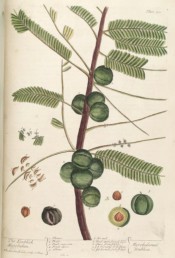Phyllanthus emblica L.
A much-branched, frost tender deciduous shrub or small tree with light, elegant foliage, flushed pink when young. To 15m. It produces very acid, pectin-rich fruit which are a good source of carbohydrates, vitamin C and minerals. [RHSD, Hortus].
Horticultural & Botanical History
Introduced to Britain in 1768, it was figured in Loddiges’ Botanical Cabinet. ‘A native of the East Indies, Cochin China, and China. In Malabar it becomes a small tree of twelve or fourteen feet high, and the fruit, which is much larger than a cherry, is eatable. The leaves are extremely elegant, being long and slender pinnate; they seem to be never wholly developed, as at the ends always appear the rudiments of more leaflets. The flowers are produced on the footstalk: they are small but very curious.’ [LBC no.548/1821].
‘The Emblick Myrobalon. Myrobalanus Emblica. This tree grows about 24 foot high, the leaves are a dark green above & a light green underneath, and the flowers white, with white stamina and yellow apices; and the fruit a pale green; both without and within. This specimen I had from the Malabar Garden, Vol. 1. Tab.38 & the fruit that is open and divided I did from the life. It grows in several parts of the East Indies. This species of the Myrobalans is said to purge phlegm at first & afterwards choler; and are an ingredient in the Decoctum Epithymi.’ [Blackwell pl.400/1739].
History at Camden Park
Listed only in the 1857 catalogue [T.755/1857]. This could the Phyllanthus sp. obtained from the Sydney Botanic Garden on 17th October 1853 [RBGS AB] but Breynia nivosa Small, which see, is perhaps more likely.
Notes
Published Feb 20, 2010 - 02:24 PM | Last updated Jul 18, 2010 - 03:35 PM
| Family | Euphorbiaceae |
|---|---|
| Category | |
| Region of origin | Tropical Asia |
| Synonyms |
|
| Common Name | Emblic, Myrobalon |
| Name in the Camden Park Record |
Phyllanthus variegata |
| Confidence level | low |


